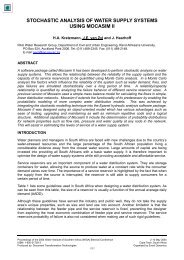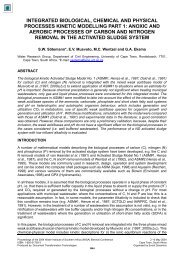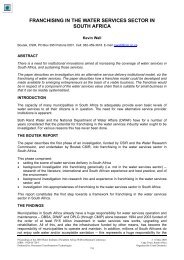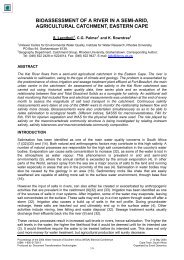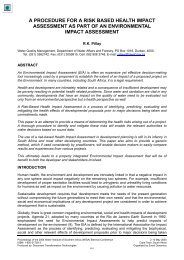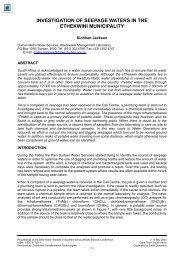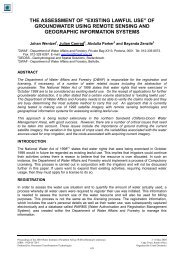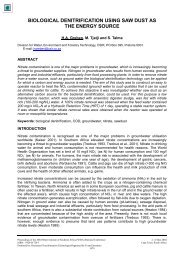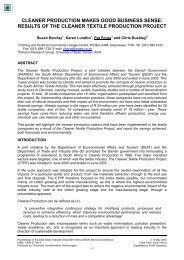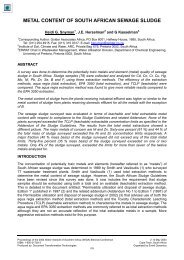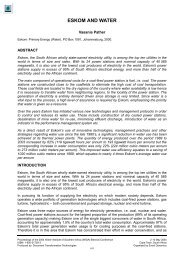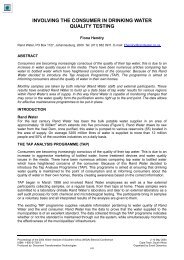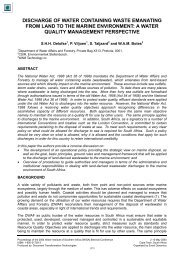The Challenges and Implications of Assessing ... - eWISA
The Challenges and Implications of Assessing ... - eWISA
The Challenges and Implications of Assessing ... - eWISA
You also want an ePaper? Increase the reach of your titles
YUMPU automatically turns print PDFs into web optimized ePapers that Google loves.
THE CHALLENGES AND IMPLICATIONS OF ASSESSING<br />
GROUNDWATER RECHARGE: A CASE STUDY ON NORTHERN<br />
SANDVELD, WESTERN CAPE, SOUTH AFRICA<br />
Julian Conrad 1 , Jaco Nel 2 <strong>and</strong> Johan Wentzel 2<br />
1 GEOSS - Geohydrological <strong>and</strong> Spatial Solutions, Innovation Centre, Techno Park, Stellenbosch, 7600.<br />
Tel: 021-8801079. Fax: 021-8801164. E-mail: julian@geoss.co.za<br />
2 DWAF - Department <strong>of</strong> Water Affairs <strong>and</strong> Forestry, Pretoria.<br />
ABSTRACT<br />
<strong>The</strong> Department <strong>of</strong> Water Affairs <strong>and</strong> Forestry (DWAF) is currently carrying out detailed<br />
hydrogeological studies within the northern S<strong>and</strong>veld area, Western Cape, South Africa. In addition<br />
DWAF funded preliminary studies have also been carried out in the area assessing hydrological,<br />
ecological <strong>and</strong> botanical components. <strong>The</strong> area is receiving much attention due to its<br />
environmental uniqueness (part <strong>of</strong> the area is a RAMSAR site) <strong>and</strong> its significant groundwater<br />
resources, which are being utilised for agricultural purposes <strong>and</strong> municipal water supply. In certain<br />
areas this groundwater abstraction is impacting on the surface water flows, groundwater <strong>and</strong><br />
associated ecosystems.<br />
In underst<strong>and</strong>ing the systems <strong>and</strong> their inter-relationships within the area, it is necessary to carry<br />
out water balance calculations. In carrying out such calculations, the quantification <strong>of</strong> the “input”<br />
component <strong>and</strong> associated temporal <strong>and</strong> spatial variability is important to address. With special<br />
emphasis on groundwater recharge, the area may be receiving both direct groundwater recharge,<br />
(as a consequence <strong>of</strong> precipitation), <strong>and</strong> distant groundwater inflow, via the large faults that<br />
transect the area, which may be importing groundwater from the inl<strong>and</strong> recharge areas (i.e. the<br />
Cederberg Mountains).<br />
One <strong>of</strong> the aims <strong>of</strong> the detailed hydrogeological study that is being carried out in the area, is to<br />
quantify both direct groundwater recharge <strong>and</strong> groundwater inflow into the study catchments. This<br />
paper outlines the setting <strong>of</strong> the project <strong>and</strong> the methods used to quantify direct recharge <strong>of</strong><br />
groundwater in the northern S<strong>and</strong>veld. It must be noted that the groundwater studies are not<br />
complete <strong>and</strong> the results presented here are still preliminary. <strong>The</strong> groundwater recharge<br />
quantification has huge significance for the Resource Directed Measures that are also being<br />
carried out in the area, in line with the requirements <strong>of</strong> the South African National Water Act <strong>of</strong><br />
1998. <strong>The</strong> Resource Directed Measures are aimed at ensuring water resource use <strong>and</strong><br />
development is balanced by protection measures thereby guaranteeing the sustainable use <strong>of</strong> the<br />
resource.<br />
INTRODUCTION<br />
In order to optimally manage a groundwater resource that is being utilised, it is highly beneficial to<br />
carry out water balance calculations. One <strong>of</strong> the components <strong>of</strong> the water balance equation is the<br />
rate <strong>of</strong> groundwater input that needs to be determined. This input can be subdivided into three<br />
main components, namely: direct (vertical) recharge; recharge from river flow; <strong>and</strong> lateral inflow.<br />
For the study being carried out it is particularly important that the inputs be accurately determined.<br />
<strong>The</strong> study area is located in the northern S<strong>and</strong>veld, Western Cape, South Africa (see Figure 1).<br />
<strong>The</strong> main reason for the area being studied is that it is a low rainfall area where significant<br />
groundwater abstraction occurs for both municipal <strong>and</strong> agriculture purposes. In addition, sensitive<br />
<strong>and</strong> important ecosystems in the area are showing varying degrees <strong>of</strong> impact. <strong>The</strong> objective <strong>of</strong><br />
these studies is to underst<strong>and</strong> the environmental linkages with surface <strong>and</strong> groundwater, <strong>and</strong><br />
Proceedings <strong>of</strong> the 2004 Water Institute <strong>of</strong> Southern Africa (WISA) Biennial Conference 2 –6 May 2004<br />
ISBN: 1-920-01728-3 Cape Town, South Africa<br />
Produced by: Document Transformation Technologies Organised by Event Dynamics
impacts resulting from groundwater use so management measures can be designed <strong>and</strong><br />
implemented to ensure ongoing sustainable development <strong>of</strong> the area.<br />
It is particularly important to define groundwater inputs <strong>and</strong> especially direct recharge as significant<br />
economic benefit is being derived from groundwater usage by the agricultural sector, whilst the<br />
highly dependent ecosystems within the area are also very groundwater dependent <strong>and</strong> showing<br />
signs <strong>of</strong> being stressed <strong>and</strong> significantly impacted. Thus a balance needs to be sought between<br />
resource utilisation <strong>and</strong> ecological protection. De Vries <strong>and</strong> Simmers (2002) (1) state that the<br />
quantification <strong>of</strong> groundwater recharge is a prerequisite for efficient <strong>and</strong> sustainable<br />
groundwater-resource management in arid regions. <strong>The</strong>y also state that recharge is defined in the<br />
general sense as the downward flow <strong>of</strong> water reaching the water table, forming an addition to the<br />
groundwater reservoir.<br />
This paper discusses the main challenges associated with determining vertical groundwater<br />
recharge in an arid to semi-arid environment.<br />
BACKGROUND INFORMATION<br />
<strong>The</strong>re are many references in international literature that state that groundwater recharge is one <strong>of</strong><br />
the most difficult components <strong>of</strong> the hydrologic budget to quantify (Stephens <strong>and</strong> Knowlton, 1986 (2) ;<br />
Jackson <strong>and</strong> Rushton, 1987 (3) ; Cook <strong>and</strong> Kilty, 1992 (4) ; <strong>and</strong> Stone et al., 2001 (5) ). <strong>The</strong>re is an<br />
increased difficulty in dealing with arid regions because <strong>of</strong> the variability <strong>of</strong> recharge with respect to<br />
time <strong>and</strong> space that is characteristics <strong>of</strong> arid areas (Verma, 1979 (6) ; Yair <strong>and</strong> Lavee, 1985 (7) ; <strong>and</strong><br />
Simmers 1988 (8) ).<br />
Natural recharge to an aquifer in an arid region may occur by various mechanisms, such as<br />
infiltration from the beds <strong>of</strong> ephemeral rivers (Moench <strong>and</strong> Kisiel 1970 (9) ; Besbes et al. 1978 (10) ;<br />
Abdulrazzak 1983 (11) ; Dillon <strong>and</strong> Liggett 1983 (12) ; Lloyd 1986 (13) ; Walters 1990 (14) ; Sorman <strong>and</strong><br />
Abdulrazzak 1993 (15) ), subsurface drainage from mountain areas through the alluvial material <strong>of</strong><br />
valley beds (Khazaei 1999 (16) ) <strong>and</strong> the direct entrance <strong>of</strong> rainfall into the alluvial material <strong>of</strong> the<br />
lower plains (Dincer et al. 1974 (17) ). In order to develop a successful recharge estimation approach<br />
for a region, the effects <strong>of</strong> all the mechanisms must be taken into account. To achieve this<br />
objective, Miles <strong>and</strong> Rushton (1983) (18) <strong>and</strong> Simmers (1989) (19) recommend a total catchment water<br />
balance approach. In this method all the factors affecting the recharge in the catchment, such as<br />
precipitation, evaporation, surface run<strong>of</strong>f, interflow, groundwater inflow <strong>and</strong> outflow, are<br />
incorporated (Senarath <strong>and</strong> Rushton 1984) (20) .<br />
With regard to groundwater recharge studies carried out on the South African west coast in the<br />
primary aquifers, a number <strong>of</strong> recharge values have been calculated. For the Atlantis area,<br />
V<strong>and</strong>oolaeghe <strong>and</strong> Bertram (1982) (21) used the water balance method to calculate a recharge rate<br />
<strong>of</strong> 26% <strong>of</strong> the rainfall (380mm/a). Bredenkamp <strong>and</strong> V<strong>and</strong>oolaeghe (1982) (22) calculated a recharge<br />
rate <strong>of</strong> 25% (rainfall <strong>of</strong> 380mm pa) also using a water balance method. <strong>The</strong>y felt that a rate <strong>of</strong><br />
30 - 35% was not impossible. Bredenkamp (1982) (23) modelled conditions at Atlantis <strong>and</strong> came up<br />
with a recharge rate <strong>of</strong> 21% <strong>of</strong> a total rainfall <strong>of</strong> 350mm pa.<br />
Timmerman (1985) (24) working between the Berg River <strong>and</strong> El<strong>and</strong>s Bay estimated a recharge rate<br />
<strong>of</strong> 15% in an area where the rainfall varies between 200 <strong>and</strong> 316mm pa. While investigating the<br />
Lower Berg River area Timmerman (1985) (25) once again suggested 15% as the recharge rate<br />
(rainfall varies between 200 <strong>and</strong> 380 mm pa). In the Graafwater area (rainfall <strong>of</strong> 250mm pa)<br />
Timmerman (1986) (26) assumed a "conservative" recharge rate <strong>of</strong> 8%. In the investigation at<br />
Str<strong>and</strong>fontein (1988) Timmerman (1988) (27) adopted a different approach - he stated that recharge<br />
would not occur on a yearly basis, but only sporadically. <strong>The</strong>y suggested that recharge might only<br />
occur every 10 years, although a figure <strong>of</strong> 20 years would not be impossible.
Figure 1.<strong>The</strong> study area, situated on the west coast <strong>of</strong> South Africa.
At El<strong>and</strong>s Bay (rainfall <strong>of</strong> 196 mm/a) groundwater abstraction has been monitored for the last -2.5<br />
years (late 1989 to 1992). During this period water levels have not dropped at all. Abstraction<br />
must therefore equal recharge. Calculations suggest a recharge rate <strong>of</strong> 12% per annum. This<br />
figure includes some horizontal inflow, although how much is conjecture (Jolly, 1992) (28) .<br />
Gerber (1980) (29) modelled the water balance on the Cape Flats aquifer (rainfall <strong>of</strong> between 600<br />
<strong>and</strong> 750mm/a) <strong>and</strong> came up with a recharge figure <strong>of</strong> 40 % for the dune area, although he did<br />
concede that this value did not take into account evapotranspiration <strong>of</strong> water that had already<br />
reached the groundwater level. V<strong>and</strong>oolaeghe (1989) (30) used a modelling exercise to calculate the<br />
exploitation potential <strong>of</strong> a hypothetical wellfield on the Cape Flats. During this exercise recharge<br />
was found to vary between 15 <strong>and</strong> 35% <strong>of</strong> rainfall.<br />
Timmerman (1985) (31) , working on the Grootwater Aquifer at Yzerfontein (rainfall <strong>of</strong> 340mm/a) felt<br />
that 15% was the bottom limit for recharge to the aquifer. Baron (1990) (32) working on the same<br />
area selected a more conservative figure <strong>of</strong> 10%.<br />
Having presented all the above information it would appear that a vertical recharge figure <strong>of</strong> 8% is<br />
conservative for the primary aquifers <strong>of</strong> the west coast. Vegter (1995) (33) indicated a value <strong>of</strong> 8 %<br />
recharge for the El<strong>and</strong>s Bay area <strong>and</strong> 12 % for the Lamberts Bay area.<br />
However there is literature that raises the possibility that the recharge percentage may be<br />
significantly less. Foster et al (1982) (34) working on Ecca aquifers in the Kalahari (Botswana)<br />
calculated that during average rainfall years (450 mm/a) no groundwater recharge would occur in<br />
areas where the soil/s<strong>and</strong> cover was deeper that 4 m. <strong>The</strong> rainfall would be stored in the s<strong>and</strong>s<br />
<strong>and</strong> then evapotranspirated. Recharge would only occur in areas where the soil cover was thin or<br />
non-existent. Working in the same area Mazor (1982) (35) however, refutes Foster et al (1982).<br />
Mazor (1982) maintains that water level measurements, <strong>and</strong> elevated tritium values prove that<br />
recharge does take place, although he ascertains that this is only in above-average rainfall years.<br />
He felt that preferential recharge zones exist within the s<strong>and</strong> cover, <strong>and</strong> recharge would occur, but<br />
with a time lag <strong>of</strong> up to four months, dependant on the s<strong>and</strong> thickness.<br />
GEOLOGICAL AND HYDROGEOLOGICAL SETTING OF THE STUDY AREA<br />
Geology<br />
Basement rocks <strong>of</strong> the Malmesbury Group, Gariep Supergroup <strong>and</strong> Cape Supergroup underlie the<br />
S<strong>and</strong>veld area. Rocks <strong>of</strong> the Malmesbury Group <strong>and</strong> Gariep Supergroup are primarily s<strong>of</strong>t, easy<br />
weathering argillaceous rocks, whilst rocks <strong>of</strong> the Cape Supergroup form the Cedarberg mountain<br />
ranges on the eastern fringe <strong>of</strong> the S<strong>and</strong>veld. Thick quartzose s<strong>and</strong>stones <strong>of</strong> the Table Mountain<br />
Group dominate the Cape Supergroup. Cenozoic deposits extensively cover the coastal plain.<br />
<strong>The</strong> area has undergone a series <strong>of</strong> deformation events, resulting in the structural geology <strong>of</strong> the<br />
area having a NW-SE structural grain. <strong>The</strong> S<strong>and</strong>veld is situated within the western branch <strong>of</strong> the<br />
Cape Fold Belt. Faults formed during the Mesozoic break-up <strong>of</strong> Gondwana have a similar<br />
orientation, but include a subsidiary WNW-ESE trend <strong>of</strong> fractures that were subsequently intruded<br />
by dolerite to form regional dykes. Most <strong>of</strong> the geophysical anomalies found during an airborne<br />
study may be explained in terms <strong>of</strong> known structural fabrics. However, this work revealed major,<br />
hitherto undiscovered faults <strong>and</strong> dykes that occur beneath the s<strong>and</strong> cover in several places (see<br />
Figure 2).<br />
Rifting <strong>of</strong> the Atlantic margin <strong>and</strong> subsequent drifting were followed by continuous erosion <strong>of</strong> the<br />
rock superstructure from about 120 Ma ago to the present. Several fluctuations <strong>of</strong> sea level during<br />
middle <strong>and</strong> late Cenozoic times produced the lowermost <strong>of</strong> the Cenozoic deposits in the S<strong>and</strong>veld.<br />
Extensive Quaternary s<strong>and</strong> deposits in turn cover these deposits.<br />
Recently the Council <strong>of</strong> Geoscience reviewed the 1:250 000 geological mapping carried out in the<br />
area. Particular attention was given to geological structures <strong>and</strong> the production <strong>of</strong> geological<br />
cross-sections (de Beer, 2003) (36) . Currently the Council for Geoscience is mapping the geology <strong>of</strong><br />
the S<strong>and</strong>veld area at a scale <strong>of</strong> 1:50 000.
Figure 2. <strong>The</strong> main geological formations <strong>and</strong> structural features within the study area.
Hydrogeology<br />
<strong>The</strong> area comprises both unconsolidated primary <strong>and</strong> fractured-rock secondary aquifers. <strong>The</strong><br />
primary aquifer is located on the western or coastal side <strong>of</strong> the study area. <strong>The</strong> aquifer comprises<br />
coarse grained <strong>and</strong> clean s<strong>and</strong>, <strong>and</strong> is typically high yielding. <strong>The</strong> aquifer thickness varies<br />
considerably <strong>and</strong> is controlled to some degree by palaeotopography. <strong>The</strong> groundwater table is<br />
typically shallow throughout the area <strong>and</strong> is also vulnerable to contamination. <strong>The</strong> primary aquifer<br />
is the main aquifer used for agricultural <strong>and</strong> domestic water supply purposes. Groundwater quality<br />
<strong>of</strong> the primary aquifer varies significantly. Salinity increases toward the coast, but is still used for<br />
agriculture purposes along the coastal zone. In general, groundwater levels mimic surface<br />
topography, but groundwater divides are not coincident with surface water divides (i.e. catchment<br />
boundaries). <strong>The</strong> general groundwater flow direction is westwards toward the coast.<br />
<strong>The</strong> secondary aquifer is significant throughout the area. Structural features such as fault planes,<br />
weathered zones <strong>and</strong> bedding surfaces largely control groundwater flow in the aquifer. <strong>The</strong><br />
secondary aquifer extends to the west beneath the primary aquifer. <strong>The</strong>re is good connectivity<br />
between the primary <strong>and</strong> secondary aquifer. In general, the piezometric head <strong>of</strong> the secondary<br />
aquifer is higher than the water table in the secondary aquifer, suggesting discharge from the<br />
secondary aquifer into the primary aquifer. High borehole yields are obtained from well-sited<br />
boreholes <strong>and</strong>, in general, groundwater quality is good. <strong>The</strong> secondary aquifer is also used to<br />
supply groundwater for irrigation purposes.<br />
<strong>The</strong>re is seasonal interaction between surface water bodies <strong>and</strong> groundwater, although river flows<br />
during the hot, dry summer months become negligible. A number <strong>of</strong> springs are found throughout<br />
the area.<br />
600<br />
400<br />
200<br />
0<br />
-200<br />
-400<br />
-600<br />
NE Cross Section 2<br />
SW<br />
G47829<br />
Og<br />
Opi<br />
Jakkals<br />
River<br />
G47828<br />
Og<br />
Op<br />
G47826<br />
Langvlei<br />
River<br />
<br />
<br />
<br />
<br />
<br />
Npo<br />
-800<br />
0 2000 4000 6000 8000 10000 12000 14000 16000 18000 20000 22000 24000 26000<br />
Npo<br />
G47818<br />
G47832<br />
G47834<br />
Og<br />
G47847<br />
G33943<br />
Cp<br />
Opi<br />
G33651<br />
Verlore<br />
Vlei<br />
Cp<br />
G31295<br />
Legend<br />
<br />
<br />
Qs Springfontein<br />
Op Peninsula<br />
Og Graafwater<br />
Opi Piekeniersklo<strong>of</strong><br />
Cp Populierbos<br />
Npo Porterville<br />
Magnetic Data<br />
Electrical Conductivity<br />
Water Level<br />
Scale<br />
Vertical : Horisontal<br />
Figure 3. Hydrogeological cross-section, across the central portion <strong>of</strong> the study area (DWAF, 2004) (37).<br />
Refer to figure 2 for the section line.<br />
Conceptual Flow Model<br />
<strong>The</strong> higher lying mountainous regions, occurring in the inl<strong>and</strong> (eastern) portion <strong>of</strong> the study area,<br />
are the main groundwater recharge zones for the area. <strong>The</strong> high hydraulic head within the<br />
recharge zone then drives this recharge water through the bedrock toward the coast. Within the<br />
bedrock there is block faulting <strong>and</strong> fracturing. Groundwater flow in the bedrock preferentially<br />
occurs along some <strong>of</strong> these faults, however there is also flow within the fractured rock matrix. A<br />
cross-section trending perpendicular to the main structural trend <strong>of</strong> the area (northwest / southeast)<br />
is shown in Figure 3 <strong>and</strong> the block-faulted nature <strong>of</strong> the area is apparent (DWAF, 2004) (37) . Faults<br />
depths, widths <strong>and</strong> degree <strong>of</strong> weathering are highly variable, <strong>and</strong> associated flow rates are thus<br />
also variable. <strong>The</strong> bedrock groundwater is <strong>of</strong> variable quality. <strong>The</strong> groundwater occurring within<br />
the primary aquifer is mainly derived from the underlying faults. Very little groundwater in the<br />
primary aquifer is derived from direct rainfall, due to the low rainfall amounts, high soil<br />
1:10
temperatures, high clay content <strong>and</strong> low soil moisture contents. In addition, piezometric levels<br />
within the secondary aquifer are shallower than water table levels in the primary aquifer <strong>and</strong> the<br />
isotopic composition <strong>of</strong> water within the primary aquifer is similar to that <strong>of</strong> inl<strong>and</strong> rainfall.<br />
GROUNDWATER RECHARGE RESULTS<br />
A number <strong>of</strong> methods have been formulated for estimating groundwater recharge, such as direct<br />
measurement, Darcian approaches, tracer techniques, isotope dating, chloride mass-balance<br />
equations, analysis <strong>of</strong> baseflow hydrographs <strong>and</strong> spring discharges, water-table fluctuations,<br />
numerical modelling, water budgeting, etc. Information about these methods is given in Gee <strong>and</strong><br />
Hillel, 1988 (38) ; Simmers, 1988, 1997 (39,40) ; Sharma, 1989 (41) ; Lerner et al., 1990 (42) ; Allison et al.,<br />
1994 (43) ; Stephens, 1994, 1996 (44,45) ; Bredenkamp et al., 1995 (46) ; Lerner, 1997 (47) ; De Vries <strong>and</strong><br />
Simmers, 2002 (48) ; <strong>and</strong> Scanlon et al., 2002 (49) . Examples <strong>of</strong> relatively low-cost investigations at<br />
regional scales are provided by Adar et al., 1988 (50) ; Gieske <strong>and</strong> De Vries, 1990 (51) ; Athavale et al.,<br />
1992 (52) ; Edmunds <strong>and</strong> Gaye, 1994 (53) ; Kennett-Smith et al., 1994 (54) ; Leaney <strong>and</strong> Herczeg,<br />
1995 (55) ; Sukhija et al., 1996 (56) ; Birkley et al., 1998 (57) ; <strong>and</strong> Rangarajan <strong>and</strong> Athavale, 2000 (58) .<br />
Choosing an appropriate technique for a particular site is not straightforward (Scanlon et al.<br />
2002) (49) , <strong>and</strong> depends on several factors, including field constraints <strong>and</strong> availability <strong>of</strong> field data.<br />
However, techniques based on groundwater levels (water-table fluctuations) are among the most<br />
widely applied methods for estimating recharge rates (Healy <strong>and</strong> Cook 2002) (59) . <strong>The</strong>se methods<br />
are based on the premise that rises in groundwater levels in unconfined aquifers are due to<br />
recharge water arriving at the water table (Scanlon et al. 2002) (49) .<br />
Chloride Mass-Balance Method<br />
From the work <strong>of</strong> DWAF (2004) three main zones are delineated based on the chloride mass<br />
balance method. <strong>The</strong> upper catchment receives about 500 mm rainfall <strong>of</strong> which 130 mm is<br />
predicted to reach groundwater (28%). <strong>The</strong> recharge zone at the foot <strong>of</strong> the mountains is expected<br />
to receive between 250 <strong>and</strong> 300 mm rainfall, with about 15 mm reaching groundwater (5%). <strong>The</strong><br />
rest <strong>of</strong> the catchment receives about 200 mm rainfall <strong>of</strong> which not more than 2 mm replenishes<br />
groundwater (1%). Groundwater level contour characteristics were used to confirm <strong>and</strong> refine the<br />
areas <strong>of</strong> groundwater recharge. <strong>The</strong> low recharge values obtained in the coastal area were also<br />
supported by anecdotal <strong>and</strong> empirical observations made by farmers active in the area (DWAF,<br />
2004) (37) .<br />
GIS Modelling<br />
In order to address the significant spatial variability <strong>of</strong> groundwater recharge occurring throughout<br />
the area, a GIS based approach was used to determine groundwater recharge distribution. Many<br />
factors were considered <strong>and</strong> an approach similar to that outlined in Conrad et al (2003) (60)<br />
considered. After discussions <strong>and</strong> testing it was decided to simplify the approach <strong>and</strong> only two<br />
factors were taken into account, namely: lithology <strong>and</strong> rainfall distribution. Based on available<br />
literature recharge percentages were assigned to the different lithological units <strong>and</strong> these<br />
percentages applied to the mean annual rainfall grid in the area. <strong>The</strong> results from the spatial<br />
modelling are shown in Figure 4. <strong>The</strong> values <strong>and</strong> distribution obtained are similar to the modelling<br />
results obtained by Umvoto-SRK (2000) (61) .<br />
Recharge Assessments – Point Data<br />
A focussed effort is currently being made on the collection <strong>of</strong> time series data <strong>of</strong> groundwater<br />
levels <strong>and</strong> rainfall. In due course a significant database will be available <strong>of</strong> groundwater <strong>and</strong> rainfall<br />
time series data. However, currently time series data is mainly available for the municipal supply<br />
wellfields within the area. An analysis <strong>of</strong> this data was carried out using a number <strong>of</strong> methods,<br />
including the chloride method, the Saturated Volume Fluctuation (SVF) Method, the Cumulative<br />
Rainfall Departure (CRD) Method <strong>and</strong> the Extended model for Aquifer Recharge <strong>and</strong> soil moisture<br />
Transport through the unsaturated Hardrock (EARTH) method. <strong>The</strong> point assessment results<br />
carried out on the boreholes with time series data are indicated in Table 1.
Table 1. Point recharge estimates based on boreholes with water level time series data <strong>and</strong> compared<br />
to the GIS modelled results.<br />
Cl method SVF CRD EARTH GIS<br />
% mm/a % mm/a % mm/a % mm/a % mm/a<br />
Graafwater<br />
wellfield<br />
1.2 2.9 1.7 4.3 1.8 4.6 3.4 8.5 0.4 1.0<br />
Wadrif<br />
wellfield<br />
1.0 1.5 1.5 2.3 1.4 2.1 0.9 1.4 ~0.3 0.45<br />
El<strong>and</strong>s Bay<br />
wellfield<br />
0.9 1.8 2.0 4.3 1.8 3.8 0.5 1.1 0.3 0.65<br />
G33946 3.3 8.3 0.3 0.8 2.3 5.7 1.2 3.0 0.2 0.5<br />
Figure 4. Groundwater recharge distribution across the study area.
DISCUSSION<br />
Prior to the detailed hydrogeological studies being carried out in the S<strong>and</strong>veld, recharge values for<br />
the primary aquifer within the study area were estimated to be conservatively 8%. As a<br />
consequence <strong>of</strong> the studies this value is considered to be high <strong>and</strong> direct recharge percentages in<br />
the region <strong>of</strong> 0.2 to 3.4 % are considered to be more realistic. <strong>The</strong> results presented in this paper<br />
are preliminary <strong>and</strong> will be reassessed once longer period water level time series data becomes<br />
available. In addition, isotopic sampling <strong>of</strong> groundwater has occurred <strong>and</strong> the results, once<br />
obtained, will also be analysed. Additional recharge methods including base flow <strong>and</strong> spring<br />
discharge techniques will also be followed up. <strong>The</strong> direct recharge is only one <strong>of</strong> the components<br />
required for quantifying groundwater inflow into the study catchments <strong>and</strong> in parallel with the<br />
recharge assessments other assessments are being carried out to determine deep seated inflow<br />
<strong>and</strong> the interaction between surface water <strong>and</strong> groundwater. <strong>The</strong> accurate quantification <strong>of</strong><br />
groundwater inflow is very important, particularly in the light <strong>of</strong> the requirements <strong>of</strong> the South<br />
African Water Act <strong>of</strong> 1998. <strong>The</strong> Water Act states that the total volume <strong>of</strong> the resource must be<br />
quantified <strong>and</strong> basic human needs <strong>and</strong> aquatic ecosystem requirements (called a Reserve) set<br />
aside from this total volume, thereafter water can be allocated to other users such as<br />
municipalities, agricultural irrigators <strong>and</strong> industry (this study area has no international resource<br />
allocation obligations). Thus quantification <strong>of</strong> the total resource, including the Reserve <strong>and</strong> legal<br />
allocations, as well as illegal usage, is necessary to ensure the sustainable utilisation <strong>of</strong> our scare<br />
water resources in South Africa.<br />
REFERENCES<br />
1. J.J. De Vries, <strong>and</strong> I. Simmers, Groundwater recharge: an overview <strong>of</strong> processes <strong>and</strong> challenges.<br />
Hydrogeology Journal 10:5-17, (2002).<br />
2. D.B. Stephens, R. Knowlton, Soil water movement <strong>and</strong> recharge through <strong>and</strong> at a semi arid site in<br />
New Mexico. Water Resour Res 22(6): 81-889, (1986).<br />
3. D. Jackson, <strong>and</strong> K.R. Rushton, Assessment <strong>of</strong> recharge components for a chalk aquifer unit. J<br />
Hydro] 92:1-15, (1987).<br />
4. P.G. Cook, <strong>and</strong> S. Kilty, A helicopter borne electromagnetic survey to delineate groundwater<br />
recharge rates. Water Resour Res, (1992).<br />
5. D.B. Stone, C.L. Moomaw, A. Davis, Estimating recharge distribution by incorporating run<strong>of</strong>f from<br />
mountainous area in an alluvium basin in Great Basin Region <strong>of</strong> the Southwestern United States.<br />
Groundwater 39(6):807-818, (2001).<br />
6. R.D. Verma, A physical model <strong>of</strong> the rainfall-run<strong>of</strong>f relationship for semiarid l<strong>and</strong>s. <strong>The</strong> hydrology <strong>of</strong><br />
areas <strong>of</strong> low precipitation. Proceedings <strong>of</strong> the Canberra Symposium. December. Int. Assoc Hydrol<br />
Sci-Assoc Int Sci Hydrol 128:215- ??7, (1979).<br />
7. A. Yair, H. Lavee, Run<strong>of</strong>f generation in arid <strong>and</strong> semiarid zones. In: Anderson MG, Burt TP (ed)<br />
Hydrological forecasting. Wiley. New York. pp 183-220, (1985).<br />
8. I. Simmers, Estimation <strong>of</strong> natural groundwater recharge. NATO ASI Series C. vol 222.<br />
Proceedings <strong>of</strong> the NATO Advanced Research Workshop, Antalya, Turkey, March 1987. Reidel,<br />
Dordrecht, ed, (1988).<br />
9. A.F. Moench, C.C. Kisiel, Application <strong>of</strong> the convolution relation to estimating recharge from an<br />
ephemeral stream. Water Resour Res 6(4):1087-1094, (1970).<br />
10. M. Besbes, J.P. Delhomme, G. De Marsily, Estimating recharge from ephemera] streams in arid<br />
regions: a case study at Kairouan. Tunisia. Water Resour Res 14:281-290, (1978).<br />
11. M.J. Abdulrazzak, Recharge from an ephemeral stream following wetting front arrival to water table.<br />
Water Resour Res 19(1): 194-200, (1983).<br />
12. P. Dillon, J.A. Liggett, An ephemeral stream-aquifer interaction model. Water Resour Res<br />
19:621-626, (1983).<br />
13. J.W. Lloyd, A review <strong>of</strong> aridity <strong>and</strong> groundwater. Hydrol Process 1:63-78, (1986)<br />
14. M.O. Walters, Transmission losses in arid regions. J Hydraul Div Am Soc Civil Eng 116(1): 129-138,<br />
(1990).<br />
15. A.U. Sorman, M.J. Abdulrazzak, Infiltration-recharge through wadi beds in arid regions. Hydro Sci J<br />
38i3 i; 173-186, (1993).<br />
16. E. Khazaei, A study <strong>of</strong> groundwater recharge in Zahedan Catchment an arid region <strong>of</strong> south eastern<br />
Iran. J Appi Hydrol XII(4):1-14, (1999).
17. T. Dincer, A. Al-Mugrin, U. Zimmermann, Study <strong>of</strong> the infiltration <strong>and</strong> recharge through s<strong>and</strong> dunes<br />
in arid zones with special reference to the stable isotopes <strong>and</strong> thermonuclear tritium. J Hydrol<br />
23:79-87, (1974).<br />
18. J.C. Miles, K.R. Rushton, A coupled surface water <strong>and</strong> groundwater catchment model. J Hydro!<br />
62:159-177, (1983).<br />
19. I. Simmers, Natural groundwater recharge estimation in semiarid zones: some state-<strong>of</strong>-art<br />
observations. Proceedings <strong>of</strong> the Sahel Forum, the State-<strong>of</strong>-Art <strong>of</strong> Hydrology <strong>and</strong> Hydrogeology in<br />
the Arid <strong>and</strong> Semi-Arid Areas <strong>of</strong> Africa, Oua- gadougou, Burkina Faso, February, pp 374-386,<br />
(1989).<br />
20. D.C. Senarath, K.R. Rushton, A routing technique for estimating groundwater recharge. Ground<br />
Water 22(2): 142-147, (1984).<br />
21. M.A.C. V<strong>and</strong>oolaeghe, <strong>and</strong> E. Bertram, Atlantis Groundwatersisteem: Herevaluasie van versekerde<br />
Lewering. Gh report # 3222, Geohydrology, Cape Town. (1982).<br />
22. D.B. Bredenkamp, <strong>and</strong> M.A.C. V<strong>and</strong>oolaeghe, Die ontginbare groundwater potensiaal van die<br />
Atlantis gebied. Gh report # 3227, Geohydrology, Cape Town, (1982).<br />
23. D.B. Bredenkamp, Evaluering van die waterpotensiaal van die kuss<strong>and</strong>e by Atlantis volgens ñ<br />
viskundige model van die grondwaterstelsel en beramings van die interferensie tussen boorgate.<br />
Gh report # 3233, Geohydrology, Pretoria, (1982).<br />
24. L.R.A. Timmerman, Preliminary report on the Cenozoic sediments <strong>of</strong> part <strong>of</strong> the Coastal Plain<br />
between the Berg River <strong>and</strong> El<strong>and</strong>’s Bay. Gh report # 3370, Geohydrology, Cape Town, (1985).<br />
25. L.R.A. Timmerman, Possibilities for the development <strong>of</strong> groundwater from the Cenozoic sediments<br />
in the lower Berg River Region. Gh report # 3374, Geohydrology, Cape Town, (1985).<br />
26. L.R.A. Timmerman, S<strong>and</strong>veld Region: Possibilities for the development <strong>of</strong> a groundwater supply<br />
scheme from a primary aquifer northwest <strong>of</strong> Graafwater. Report Gh3471, Geohydrology, Cape<br />
Town, (1986).<br />
27. L.R.A. Timmerman, Exploration for groundwater resources near Str<strong>and</strong>fontein, Doringbaai <strong>and</strong><br />
Papendorp. Gh report # 3511, Geohydrology, Pretoria, (1988).<br />
28. J. Jolly, <strong>The</strong> geohydrology <strong>of</strong> the Graafwater Government Subterranean Water Control Area. Gh #3<br />
778, Geohydrology, Cape Town, (1992).<br />
29. A. Gerber, Final report on the Geohydrology <strong>of</strong> the S<strong>and</strong> Deposits in the Cape Flats, CSIR, Pretoria,<br />
(1980).<br />
30. M.A.C. V<strong>and</strong>oolaeghe, <strong>The</strong> Cape Flats groundwater development pilot abstraction scheme. Gh<br />
report # 3655, Geohydrology, Cape Town, (1989).<br />
31. L.R.A Timmerman, Preliminary report on the Geohydrology <strong>of</strong> the Grootwater Primary Aquifer unit<br />
between Yzerfontein <strong>and</strong> the Modder River. Gh report # 3372, Geohydrology, Cape Town, (1985).<br />
32. Baron, Aquifer characteristics <strong>and</strong> recommended water allocations in the Grootwater Aquifer Unit,<br />
Yzerfontein Subterranean Government Water Control Area. Directorate Geohydrology, Dept <strong>of</strong><br />
Water Affairs <strong>and</strong> Forestry, Technical Report Gh3715, Cape Town, (1990).<br />
33. Vegter, An explanation <strong>of</strong> a set <strong>of</strong> national groundwater maps. Prepared for the Water Research<br />
Commission, Report Number TT 74/95, August (1995).<br />
34. S.S.D. Foster, A.H. Bath, J.L Farr, <strong>and</strong> W.J. Lewis, <strong>The</strong> Likelihood <strong>of</strong> Active Groundwater Recharge<br />
in the Botswana Kalahari, Journ. Of Hydrology, Vol. 55, (1980).<br />
35. E. Mazor, Rain Recharge in the Kalahari – A note on some approaches to the problem, Journ. Of<br />
Hydrology, Vol. 55, (1982).<br />
36. C.H. De Beer, <strong>The</strong> geology <strong>of</strong> the S<strong>and</strong>veld area between Lambert’s Bay <strong>and</strong> Piketberg (Project<br />
5510). Council for Geoscience, Western Cape Unit, Bellville. CGS Report No. 2003-0032, (2003).<br />
37. DWAF, Jaco Nel. Gh 4000. Groundwater potential <strong>of</strong> the Langvlei Catchment. In preprartion,<br />
(2004).<br />
38. G.W. Gee, D. Hillel, Groundwater recharge in arid regions: review <strong>and</strong> critique <strong>of</strong> estimation<br />
methods. Hydrol Proc 2:255- 266, (1988).<br />
39. I. Simmers, Estimation <strong>of</strong> natural groundwater recharge. Reidel, Boston, 510 pp, ed. (1988).<br />
40. I. Simmers, Recharge <strong>of</strong> phreatic aquifers in (semi-) arid areas. AA Balkema, Rotterdam, 277 pp,<br />
ed. (1997).<br />
41. M.L. Sharma, Groundwater recharge. A.A. Balkema, Rotter-dam, (1989).<br />
42. D.N. Lerner, Groundwater recharge. In: Saether OM, de Caritat P (eds) Geochemical processes,<br />
weathering <strong>and</strong> groundwater recharge in catchments. A.A. Balkema, Rotterdam. Pp, (1997).<br />
43. G.B. Allison, G.W. Gee, S.W. Tyler, Vadoze-zone techniques for estimating groundwater recharge<br />
in arid <strong>and</strong> semi-arid regions. Soil Sci Soc Am J 58:6-14, (1994).<br />
44. D.B. Stephens, A perspective on diffuse natural recharge mechanisms in areas <strong>of</strong> low precipitation.<br />
Soil Sci Soc Am J 58:40-48, (1994).
45. D.B. Stephens, Estimation <strong>of</strong> infiltration <strong>and</strong> recharge for environmental site assessment. API Publ.<br />
4643. Health <strong>and</strong> Environmental Sciences Department, Albuquerque, New Mexico, (1996)<br />
46. D.B. Bredenkamp, L.J. Botha, G.J. Van Tender, H.J. Van Rensburg, Manual on quantitative<br />
estimation <strong>of</strong> groundwater recharge <strong>and</strong> aquifer storativity. Rep TT73/95. Water Research<br />
Commission, Pretoria, 419 pp, (1995).<br />
47. D.N. Lerner, Groundwater recharge. In: Saether OM, de Caritat P (eds) Geochemical processes,<br />
weathering <strong>and</strong> groundwater recharge in catchments. A.A. Balkema, Rotterdam. Pp, (1997).<br />
48. J.J. De Vries, I. Simmers, Groundwater recharge: an overview <strong>of</strong> processes <strong>and</strong> challenges.<br />
Hydrogeol J 10 (1):5-17, (2002).<br />
49. B.R. Scanlon, R.W. Healy, P.G. Cook, Choosing appropriate techniques for quantifying<br />
groundwater recharge. Hydrogeol J. 10(1):18-39, (2002).<br />
50. E.M. Adar, S.P. Neuman, D.A. Woolhiser, Estimation <strong>of</strong> spatial recharge distribution using<br />
environmental isotopes <strong>and</strong> hydro- chemical data. J Hydrol 97:251-302, (1988).<br />
51. A.S.M. Gieske, J.J. De Vries, Conceptual <strong>and</strong> computational aspects <strong>of</strong> the mixing cell method to<br />
determine groundwater recharge components. J. Hydrol 121:277-292, (1990).<br />
52. R.N. Athavale, R. Rangarajan, D. Muralidharan, Measurement <strong>of</strong> natural recharge in India. J Geol<br />
Soc India 39:235-244, (1992).<br />
53. W.M Edmunds, C.B. Gaye, Estimating the variability <strong>of</strong> groundwater recharge in the Sahel using<br />
chloride. J. Hydrol T56:47-59, (1994).<br />
54. A. Kennett-Smith, P.G. Cook, G.R. Walker, Factors affecting groundwater recharge following<br />
clearing in the south-western Murray Basin. J. Hydrol 154:85-105, (1994).<br />
55. F.W. Leaney, A.L. Herczeg, Regional recharge to a karst aquifer estimated from chemical <strong>and</strong><br />
isotopic composition <strong>of</strong> diffuse <strong>and</strong> localized recharge. J. Hydrol 164:363-387, (1995).<br />
56. B.S. Sukhija, P. Nagabhushanam, D.V. Reddy, Groundwater recharge in semi-arid regions <strong>of</strong> India:<br />
an overview <strong>of</strong> results obtained using tracers. J. Hydrogeol 4(3):50-71, (1996).<br />
57. P. Birkley, V. Torres Rotriguez, P.E. Gonzalez, <strong>The</strong> water balance for the basin <strong>of</strong> the valley <strong>of</strong><br />
Mexico <strong>and</strong> implications for future water consumption. J. Hydrogeol 6(4):500-517, (1998).<br />
58. R. Rangarajan, R.N. Athavale, Annual replenishable groundwater potential <strong>of</strong> India-an estimate<br />
based on injected tritium studies. J. Hydrol 234:38-53, (2000).<br />
59. R.W. Healy, P.G. Cook, Using groundwater levels to estimate recharge. J. Hydrogeol 10(2):91-109,<br />
(2002).<br />
60. J. Conrad, S. Adams, <strong>and</strong> R. Titus, GIS based assessment <strong>of</strong> groundwater recharge in the fractured<br />
rocks <strong>of</strong> Namaqual<strong>and</strong>, South Africa. Groundwater in Fractured Rocks (2003) – Prague, Czech<br />
Republic, Krasny-Hrkal-Bruthans (eds). IAH Annual Congress, (2003).<br />
61. Umvoto-SRK, Reconnaissance investigation into the development <strong>and</strong> utilization <strong>of</strong> the Table<br />
Mountain Group Artesian Groundwater, using the E10 catchment as a pilot study area, (2000).



